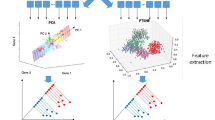Abstract
This paper presents an approach to classifying electroencephalogram (EEG) signals for brain–computer interfaces (BCI). To eliminate redundancy in high-dimensional EEG signals and reduce the coupling among different classes of EEG signals, we use principle component analysis and linear discriminant analysis to extract features that represent the raw signals. Next, we introduce the voting-based extreme learning machine to classify the features. Experiments performed on real-world data from the 2003 BCI competition indicate that our classification method outperforms state-of-the-art methods in speed and accuracy.




Similar content being viewed by others
References
Wöllmer M, Eyben F, Graves A, Schuller B, Rigoll G. Bidirectional LSTM networks for context-sensitive keyword detection in a cognitive virtual agent framework. Cognit Comput. 2010;2(3):180–90.
Mital P, Smith T, Hill R, Henderson J. Clustering of gaze during dynamic scene viewing is predicted by motion. Cognit Comput. 2011;3(1):5–24.
Wang Q-F, Cambria E, Liu C-L, Hussain A. Common sense knowledge for handwritten Chinese recognition. Cognit Comput. 2013;5(2):234–42.
Wolpaw JR, Birbaumer N, Heetderks WJ, McFarland DJ, Peckham PH, Schalk G, Donchin E, Quatrano LA, Robinson CJ, Vaughan TM. Brain–computer interface technology: a review of the first international meeting. IEEE Trans Rehabil Eng. 2000;8(2):164–73.
Wolpaw JR, Birbaumer N, McFarland DJ, Pfurtscheller G, Vaughan TM. Brain–computer interfaces for communication and control. Clin Neurophysiol. 2002;113(6):767–91.
Vallabhaneni A, Wang T, He B. Brain–computer interface, neural engineering. US: Springer; 2005. p. 85–121.
Kaper M, Meinicke P, Grossekathoefer U, Lingner T, Ritter H. BCI competition 2003-data set IIb: support vector machines for the P300 speller paradigm. IEEE Trans Biomed Eng. 2004;51(6):1073–6.
Pfurtscheller G, Neuper C, Flotzinger D, Pregenzer M. EEG-based discrimination between imagination of right and left hand movement. Electroencephalogr Clin Neurophysiol. 1997;103(6):642–51.
Chiappa, S, Bengio S. HMM and IOHMM modeling of EEG rhythms for asynchronous BCI systems. In: ESANN. 2004. p. 193–204.
Pfurtscheller G, Neuper C, Schlogl A, Lugger K. Separability of EEG signals recorded during right and left motor imagery using adaptive autoregressive parameters. IEEE Trans Rehabil Eng. 1998;6(3):316–25.
Camps-Valls G, Bruzzone L. Kernel-based methods for hyper spectral image classification. IEEE Trans Geosci Remote Sens. 2005;43(6):1351–62.
Subasi A, Erçelebi E. Classification of EEG signals using neural network and logistic regression. Comput Methods Programs Biomed. 2005;78(2):87–99.
LeVan P, Urrestarazu E, Gotman J. A system for automatic artifact removal in ictal scalp EEG based on independent component analysis and Bayesian classification. Clin Neurophysiol. 2006;117(4):912–27.
Panahi N, Shayesteh MG, Mihandoost S, Varghahan BZ. Recognition of different datasets using PCA, LDA, and various classifiers. In: Proceedings of the 5th international conference on application of information and communication technologies. 2011. 1–5.
Song Y-D, Liò P. Epileptic EEG detection via a novel pattern recognition framework. In: Proceedings of the 5th international conference on bioinformatics and biomedical engineering. 2011. 1–6.
Huang G-B, Zhu Q-Y, Siew C-K. Extreme learning machine: a new learning scheme of feed forward neural networks. In: Proceedings of IEEE international joint conference on neural networks. 2004. Vol. 2, p. 985–990.
Huang G-B, Zhu Q-Y, Siew C-K. Extreme learning machine: theory and applications. Neurocomputing. 2006;70(1):489–501.
Cao J, Lin Z, Huang G-B, Liu N. Voting based extreme learning machine. Inf Sci. 2012;185(1):66–77.
Huang G-B, Wang D-H, Lan Y. Extreme learning machines: a survey. Int J Mach Learn Cybern. 2011;2(2):107–22.
Serre D. Matrices: theory and applications. New York: Springer; 2002.
Rao CR, Mitra SK. Generalized inverse of matrices and its applications. New York: Wiley; 1971.
Blankertz B, Muller KR, Curio G, Vaughan TM, Schalk G, Wolpaw JR, Schlogl A, Neuper C, Pfurtscheller G, Hinterberger T, Schroder M, Birbaumer N. The BCI competition 2003: progress and perspectives in detection and discrimination of EEG single trials. IEEE Trans Biomed Eng. 2004;51(6):1044–51.
Duan L, Zhang Q, Yang Z, Miao J. Research on heuristic feature extraction and classification of EEG signal based on BCI Data Set. Res J Appl Sci Eng Technol. 2013;5(3):1008–14.
Deng W, Zheng Q, Chen L. Regularized extreme learning machine: computational Intelligence and data mining, CIDM’09. IEEE Symp. 2009;2009:389–95.
Kayikcioglu T, Aydemir O. A polynomial fitting and k-NN based approach for improving classification of motor imagery BCI data. Pattern Recognit Lett. 2010;31(11):1207–15.
Mensh BD, Werfel J, Seung HS. BCI competition 2003-data set Ia: combining gamma-band power with slow cortical potentials to improve single-trial classification of electroencephalographic signals. IEEE Trans Biomed Eng. 2004;51(6):1052–6.
Wang B-J, Jun L, Bai J, Peng L, Li Y, Li G. EEG recognition based on multiple types of information by using wavelet packet transform and neural networks, engineering in medicine and biology society, 2005. IEEE-EMBS 2005. 27th annual international conference of the IEEE. 2006: 5377–5380.
Sun S, Zhang C. Assessing features for electroencephalographic signal categorization, acoustics, speech, and signal processing, 2005. Proceedings (ICASSP’05) IEEE international conference on IEEE, 5: v/417–v/420 Vol. 5, 2005.
Wu T, Yan G-Z, Yang B-H, Sun H. EEG feature extraction based on wavelet packet decomposition for brain computer interface. Measurement. 2008;41(6):618–25.
Bostanov V. BCI competition 2003-data sets Ib and IIb: feature extraction from event-related brain potentials with the continuous wavelet transform and the t value scalogram. IEEE Trans Biomed Eng. 2004;51(6):1057–61.
Acknowledgments
This research is partially sponsored by the Natural Science Foundation of China (Nos. 61175115, 61272320, 61001178, 61003105 and 61370113), the Importation and Development of High-Caliber Talents Project of Beijing Municipal Institutions (CIT&TCD201304035, CIT&TCD201404052), the Jing-Hua Talents Project of Beijing University of Technology (2014-JH-L06), the Ri-Xin Talents Project of Beijing University of Technology (2014-RX-L06) and the International Communication Ability Development Plan for Young Teachers of Beijing University of Technology (No. 2014-16).
Author information
Authors and Affiliations
Corresponding author
Rights and permissions
About this article
Cite this article
Duan, L., Zhong, H., Miao, J. et al. A Voting Optimized Strategy Based on ELM for Improving Classification of Motor Imagery BCI Data. Cogn Comput 6, 477–483 (2014). https://doi.org/10.1007/s12559-014-9264-1
Received:
Accepted:
Published:
Issue Date:
DOI: https://doi.org/10.1007/s12559-014-9264-1




